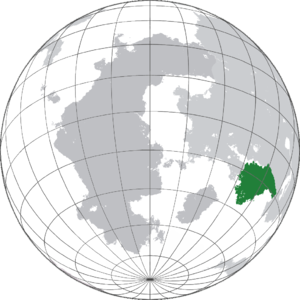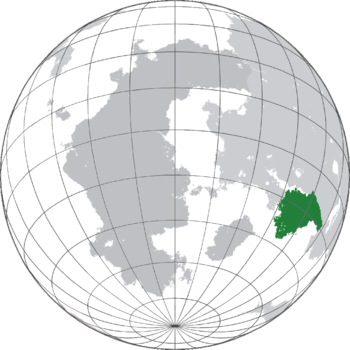Difference between revisions of "The Armed State Of Verkimlund"
Verkimlund (talk | contribs) |
Verkimlund (talk | contribs) |
||
| Line 111: | Line 111: | ||
===Arrival of Dolphik Settlers(1752)=== | ===Arrival of Dolphik Settlers(1752)=== | ||
Traveling aboard the HMS New Hope, Captain Thomas Seafourth, a captain of the Royal Navy, Originally sighted The coast of Verkimlund in 1750 while mapping the Vozun Ocean for Royal Navy Charts, Originally thought of only as farmland and gazing grounds exploration groups set out to evaluate the land for the growing of crops in demand in Dolphikland at the time, these groups eventually reached what would later be named the Nurt cape where they found an abundance of Gold and other Raw Minerals. Six years after the first group landed in 1758 an authorised effort led by Paul Valber landed on The Cape establishing a Colony at Wekeland, in the south west of the Verkimland Plain's work began to build the necessary infrastructure to allow mining and feeding of the mining population, To allow this to happen without needing to use local, illiterate and non dolfik speaking labour, prisoners from the mainland were utilised as labourers, these labourers coming from industrial canters and criminal backgrounds began using Local Theives Cants from around Dolifkland to communicate without the knowledge of their Dolphik guards, this would evolve and soon became what would be recognised as Verkim. | Traveling aboard the HMS New Hope, Captain Thomas Seafourth, a captain of the Royal Navy, Originally sighted The coast of Verkimlund in 1750 while mapping the Vozun Ocean for Royal Navy Charts, Originally thought of only as farmland and gazing grounds exploration groups set out to evaluate the land for the growing of crops in demand in Dolphikland at the time, these groups eventually reached what would later be named the Nurt cape where they found an abundance of Gold and other Raw Minerals. Six years after the first group landed in 1758 an authorised effort led by Paul Valber landed on The Cape establishing a Colony at Wekeland, in the south west of the Verkimland Plain's work began to build the necessary infrastructure to allow mining and feeding of the mining population, To allow this to happen without needing to use local, illiterate and non dolfik speaking labour, prisoners from the mainland were utilised as labourers, these labourers coming from industrial canters and criminal backgrounds began using Local Theives Cants from around Dolifkland to communicate without the knowledge of their Dolphik guards, this would evolve and soon became what would be recognised as Verkim. | ||
| + | |||
| + | ===Establishment of the State Capitals (1755)=== | ||
| + | Across 1755 Multiple Attempts were made to establish additional Colonial Settlements in order to find and exploit further natural resources within the nation, the most successful of these being the settlement of Salisbury which utilised Existing Verkim Labourers from Wekeland and Estvel that was the first endeavour in the nation to use largely native Manpower from the local population compensating the Local Kraals for their effort with food and resources taken from the Wekeland Mining endeavours. | ||
===Kettali Range Skirmish (1759)=== | ===Kettali Range Skirmish (1759)=== | ||
Revision as of 17:06, 31 March 2021
The Armed State Of Verkimlund Die Gewapende Staat Verkimlund | |
|---|---|
|
Flag | |
Motto: "Vir die goeie van al" "For the good of all" | |
Anthem: Verkimlund Stands March: March of the Verkimlund Regiment | |
| Location | Verkimlund makes up much of the south western coast of Cancodia. |
| Capital and largest city | Salisbury |
| Official languages |
|
| Recognised regional languages |
|
| Ethnic groups | |
| Religion |
|
| Demonym(s) | Verkimlunder |
| Government | Parliamentary Democracy |
| Peiter Koch | |
| Ian Holder | |
| Legislature | Housevaaler |
| Kings Court | |
| Tribal Council | |
| Establishing Events | |
• Dolphik Colonisation | 1792 |
• Signing of the Charter Of Self Rule | 1893 |
• End of the Confederation | 1920 |
| Area | |
• Total | 100,000 km2 (39,000 sq mi) (N/A) |
• Water (%) | 5.7 |
| Population | |
• April 2021 estimate | |
• 2011 census | 4,545,425 |
• Density | 45.45/km2 (117.7/sq mi) (3rd) |
| GDP (PPP) | 2021 estimate |
• Total | |
• Per capita | |
| GDP (nominal) | 2021 estimate |
• Total | |
• Per capita | |
| Gini (2021) | low · N/A |
| HDI (2020) | very high · N/A |
| Currency | Rand (VRD) |
| Date format | dd/mm/yyyy |
| Driving side | left |
| Calling code | +800 |
The Armed State Of Verkimlund, formerly The Confederated Dominion Of Verkimlund And Teleland, commonly known as Verkimlund, is a sovereign nation in south west Cancodia. The nation includes the States of Kettalli, Transvaal, Nurt Cape, Tetlebele, and The Cape. The nation shares a land border with Traestan on its north western face and a land border with Nostrapais on its eastern side, to its south is the Vozun Ocean. The union of Verkimlund and Teleland (The greater collection of Kettali and Telebele) was signed into law in 1893 with the Colonial Communion Act of the same year. The small nation boosts a reasonable military for its size and wealth due to a long running tradition of National Service particularly among minority groups. Verkimlund is a signed Member of the International Trade Sphere aswell as International Space Cooperation Program. Exports from the nation are largely Raw Minerals and Small arms sold to private individuals.
Etymology
The Name "Verkimlund" Roughly translates from Verkim To "New Land" but older texts of Verkim settlers actually translate it to "Our Land" Taken litterally the name translates to "Land of Verkim" which has led to some controversy among non Verkim Speaking Populations of the nation
History
Precolonial History(?-1750)
Arrival of Dolphik Settlers(1752)
Traveling aboard the HMS New Hope, Captain Thomas Seafourth, a captain of the Royal Navy, Originally sighted The coast of Verkimlund in 1750 while mapping the Vozun Ocean for Royal Navy Charts, Originally thought of only as farmland and gazing grounds exploration groups set out to evaluate the land for the growing of crops in demand in Dolphikland at the time, these groups eventually reached what would later be named the Nurt cape where they found an abundance of Gold and other Raw Minerals. Six years after the first group landed in 1758 an authorised effort led by Paul Valber landed on The Cape establishing a Colony at Wekeland, in the south west of the Verkimland Plain's work began to build the necessary infrastructure to allow mining and feeding of the mining population, To allow this to happen without needing to use local, illiterate and non dolfik speaking labour, prisoners from the mainland were utilised as labourers, these labourers coming from industrial canters and criminal backgrounds began using Local Theives Cants from around Dolifkland to communicate without the knowledge of their Dolphik guards, this would evolve and soon became what would be recognised as Verkim.
Establishment of the State Capitals (1755)
Across 1755 Multiple Attempts were made to establish additional Colonial Settlements in order to find and exploit further natural resources within the nation, the most successful of these being the settlement of Salisbury which utilised Existing Verkim Labourers from Wekeland and Estvel that was the first endeavour in the nation to use largely native Manpower from the local population compensating the Local Kraals for their effort with food and resources taken from the Wekeland Mining endeavours.
Kettali Range Skirmish (1759)
In late 1759 Miners on the Kettali Range, Fired on Kettali Tribesmen killing 3 when they attempted to move the miners away from a nearby kraal that the miners did not have knowledge of at the time, it was believed at the time that the Tribesmen, who numbered between 50 and 60 from sources from the period were mounting an attack, after a single volley the skirmish ended with the Kettali retreating from the field, the kraal similarly was abandoned at some point shortly after.
The Dolphik-Kettali War(1760-1765)
In early 1960 under the command of Paul Valber, the Wekeland Garrison, comprising of 1 company of Verkim Milita marched to their mining interests in Kettali under the flag of the Dolphik Crown to address concerns of Native Retribution for the earlier Kettali Range Skirmish, The force made Camp at Seleko before marching on towards the New Adnburg Mining Purchase the next morning, during that night on the 3rd of January 1760 Kettali Braves attempted to ambush the column in camp, killing Paul Valber and 17 Men under his command before being repulsed by the remaining force now under the command of an acting Lieutenant. The resulting war, being fought largely by Verkim Volunteers and Dolfik Officers lasted a little under 5 years and resulting in the Kettali Nation being severely cut down in size aswell as the increase of prison population to afford replacement labourers for those who had volunteered to fight.
The resulting logistical situation saw rise to the first generation of Verkim Rangers, Prison labourers given bond to build a home along well worn supply lines and mining routes, to patrol and secure the route from both wildlife and Kettali raids, Outside of the Parliament building in Salisbury one such ranger is immortalised looking over the square from horseback in the form of the ranger monument. While no official record was kept of the numbers of such Rangers, the houses built along such routes still exist and suggest numbers from between 1,000 and 3,000 during the period of the Kettali War.



